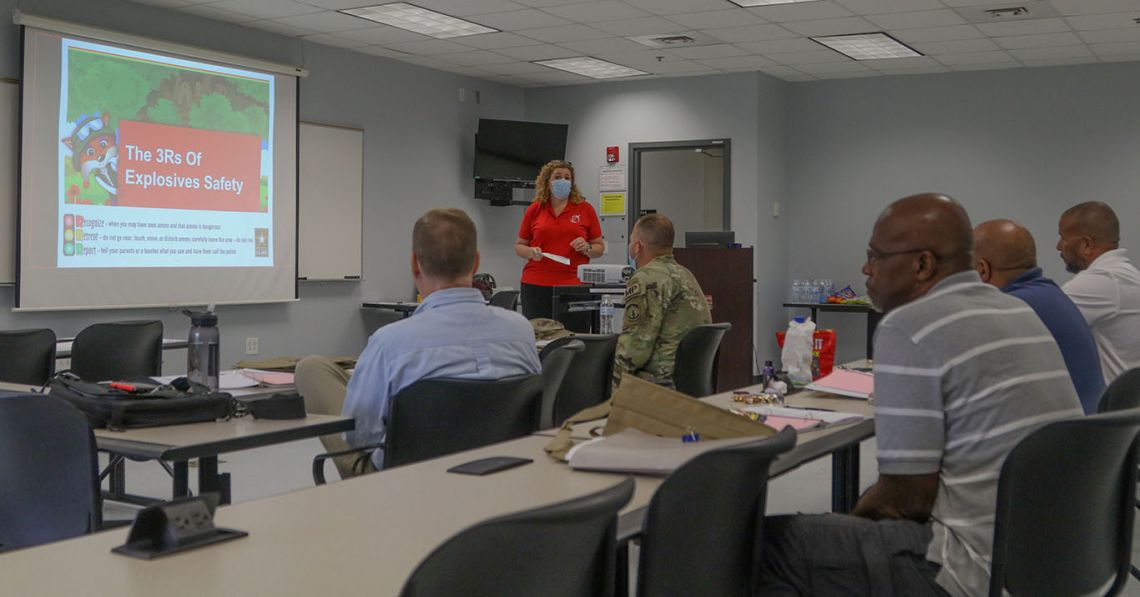06/09/2022 Stati Uniti, Georgia, (Liberty-Bryan), Fort Stewart
“If you ever come across anything suspicious like this item, please do not pick it up, contact your local law enforcement agency for assistance”
Pfc. Bernabe Lopez–3rd Infantry Division
Kara-Beth Dambaugh, the 3Rs program training lead, holds a “train-the-trainer’’ class at the Army Education Center, Aug. 24 on Fort Stewart. 3Rs Explosive Safety Education Program teaches trainers the skills necessary to teach the three steps of the 3Rs program: recognize, retreat and report, which are used to help mitigate the dangers of unexploded ordnance. The 3Rs explosive safety education program held a class Aug. 23-25 on Fort Stewart, to teach future 3Rs trainers how to instruct others on the dangers of unexploded ordnance and the steps necessary to mitigate those dangers when UXO is encountered. The 3Rs stand for recognize, retreat, and report, which form the basis for this explosives safety education program. This specific course is designed to teach instructors the proper steps of identifying and reporting munitions found on or near military installations, which they can take back to lead 3Rs training in their own organizations and throughout the local area. “You are being trained today with the goal that everyone in your division or directorate will know what the 3Rs program is,” said Kara-Beth Dambaugh, the 3Rs program training lead. According to a 3Rs training guide, the 3Rs program is an Army-wide explosive safety program developed in 2000, which provides a consistent message for use at all active, reserve and formerly-used installations. Using the 3Rs method, Soldiers and civilians can quickly understand the process for identifying and reacting to UXO. Recognize: a person recognizes possible or probable UXO and understands the dangers they pose. Retreat: occurs after an individual recognizes possible munitions and moves to safety using the same path taken prior to discovering the munitions to avoid the possibility of stepping onto additional UXO. Report: after discovering possible munitions and retreating to a safe distance, an individual reports the discovery of UXO to local authorities so the necessary process for proper disposal may occur. UXO is a real danger on and around military bases, and anyone who operates near a military installation should understand the 3Rs process to protect themselves and their loved ones. “When doing an outreach event to the general public, the message is always the same,” Dambaugh said. “If you work on, live on, or live around an installation that uses or has used munitions, then you need to know about the potential hazards of munitions. You need to know about the 3Rs program.” Following the completion of these classes, the newly-minted trainers are prepared to plan outreach events for Fort Stewart communities and train others about the importance of the 3Rs program. These soon-to-be trainers will provide knowledge to the entire community outside of Fort Stewart, and enable a better understanding of the dangers of UXO and the steps necessary to mitigate those dangers, explained Chris Woods, a safety specialist for the Fort Stewart Garrison safety office. More information about the 3Rs program can be found online at denix.osd.mil/uxo/home/.
If you find anything that appears to be an explosive device, do not touch it, leave it where it is and call the police. We will contact the appropriate agencies to properly dispose of the item.
Dear editors, Biography of a bomb is aimed at highlighting the danger caused by unexploded bombs. Moreover, the most important aspect is that we work completely non profit, raising awerness about this topic is what drives us. We apologize if we make use of pictures in yours articles, but we need them to put a context in how findings are done. We will (and we always do) cite source and author of the picture. We thank you for your comprehension





